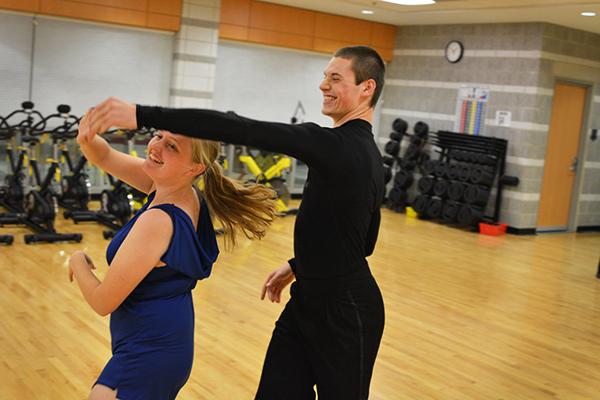The Grand Ballroom of the Marvin Center is in motion. Young couples in black pants and high-heeled dancing shoes glide, circling each other. Some perform Latin dances, like the Rumba. Others practice the Foxtrot. Flouncy skirts flow to the rhythm of their feet.
The 50-member GW Ballroom hosted its first event of the competitive season Sunday. The Colonial Classic, a competition the group has dubbed a “mockatition,” is designed to give newcomers a taste of competitive ballroom without the pressure of its meticulous point system.
Couples are judged based on subtleties and the execution of specific dance moves. How well the couple holds each other, how connected they appear and how well they navigate a floor full of other dancers are all factors.
At this year’s Colonial Classic Mockatition, about 20 members each from Georgetown Ball and Ballroom at Maryland joined GW Ballroom for the low-stakes competition. It served as the centerpiece of GW Ballroom’s recruitment season: almost 30 new members attended.
“It’s also kind of like our community,” said senior Zach Humayun, the president of GW Ballroom. “We have a lot of close ties with the Georgetown and the University of Maryland teams because we spend a lot of time at the same competitions or at the same socials.”

Competitive ballroom, though fun, is also methodical: beginners alone spend at least eight hours a week dancing during the club’s four weekly practices, while more experienced dancers often clock in extra hours.
During the newcomers’ Cha-Cha segment, ballroom veterans around the room clapped and cheered in time to the music to keep their new teammates on beat. The Cha-Cha, instead of the more common eight-count, relies on a count of one-two-cha-cha-cha.
During dance time, executive board members prompted the audience to yell out the numbers of their favorite couples in support.
The club boasts varying skill levels: collegiate teams begin with the newcomer level, with bronze, silver and gold levels above it.
Humayun began dancing ballroom at the start of his freshman year, with no prior dance experience. The senior now dances at the silver level.
“I did a little bit of music theater in seventh and eighth grade, but I definitely had to walk when everyone else was dancing,” Humayun said. “I remember my senior banquet in high school. Someone described my dancing as ‘spastic.’”
Newcomers have six weeks from the start of the semester to the end of Colonial Classic to take advantage of free dance lessons and experience the thrill of competition before deciding whether to commit.
After that, regular club fees apply. Members of the social team pay $50 per semester, while competitors pay $80. The dues are mainly to pay for practice space in Lerner Health and Wellness Center (about $2,500 per semester) as well as registration fees and travel expenses for competitions.
On Sunday afternoons in the Marvin Center’s Grand Ballroom, members are free to come and go on their own time. Half of the room is dedicated to newcomer lessons. The other half is alive with experienced couples perfecting their technique.
In rehearsals before the competition, the experienced dancers demonstrated impeccable posture and rhythm in their half of the room. Meanwhile, the newcomers’ half was abuzz with excitement and determination to learn how to dance the Butterfly. They had not yet completely mastered leader and follower roles and still watched their feet as they danced, often bumping into other pairs on the floor.
Isabelle Lobley, GW Ballroom’s programming officer and a member of the competitive team, promotes a rigorous practice schedule: after all, it’s not only GW competitors who are putting in the hours.
“When you go out on the floor, you want to look like you know what you’re doing. That’s what the judges will see,” Lobley said.
Even ballroom members not competing Sunday couldn’t stop themselves from dancing to the music they know so well.
In between segments, a general dance opened up to the entire room, with newcomers mixing with gold-level dancers, and audience members trickling onto the dance floor as well.







